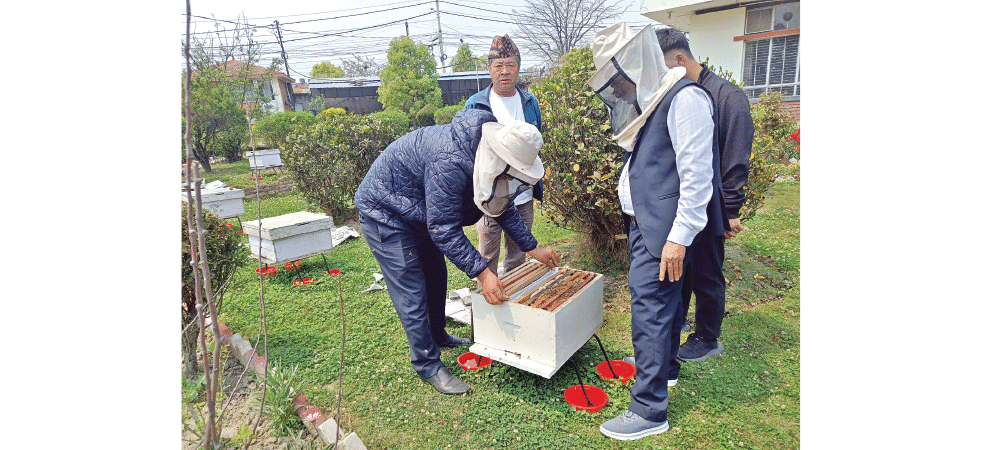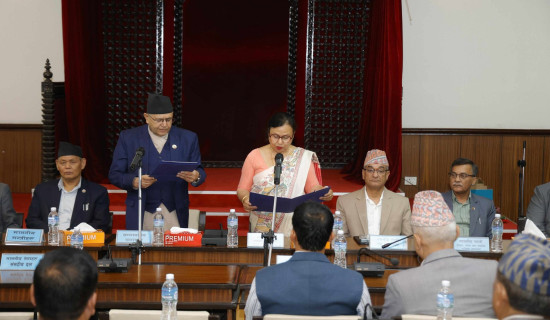- Thursday, 28 August 2025
All is not sweet about beekeeping in Nepal
By Indira Aryal,Lalitpur, Apr. 13: When Narayan Prasad Dahal was a small boy, he used to find honey bees everywhere in his surroundings in large numbers. Sometimes he used to find honey produced by the bees under his four-legged wooden bed and honeybees used to hum around his house.
But nowadays it is hard to find
them even in nature. Even though some people have professionally kept bees, it is often hard to maintain their population as they die of various diseases and lack food sources including pollen and nectar, Dahal, who is also a beekeeper, said.
Dahal, who is planning to begin beekeeping in Kathmandu, was at the National Entomology Research Centre (NERC) to discuss his ideas and the problems of mites as a whole. Dahal, who claimed to have visited all 77 districts of the country, said he used to see many honey bees during his adulthood but now wherever he goes, farmers only share the mite problem in the bee hive.
In recent times, a disease called ‘Varroa mite’ (Varroa destructor and Varroa jacobsoni) is found in adult honey bees. Varroa mite is a parasite of adult honey bees and it weakens and kills honey bees en-mass.
Seeing this alarming threat, NERC started a research named “Development of Floral Calendar and Management of Mite in Honey Bees” to identify the mite problem and address it with safe pesticides, said scientist Bishnu Neupane (sci-2) at the NERC.
“The Varroa mite disease captures the honey bees in their larva period and most of them die inside the wax, but if some survive, they are disabled and fail to collect food including pollen and nectar. This hampers the production of honey and its population will shrink too,” Neupane, who is leading the research, said.
Nepal was one of the countries to export honey before 2012. Foreigners used to take Nepal’s honey as very delicious and fragrant due to its fresh climate and the number of medicinal plants in the Himalayas but the exports were halted in many countries because the use of pesticides was noticed in beekeeping and brood harvesting, he said.
The dangerous pesticides including formic acid and Apistan were used to treat Varroa mites in beehives. “So we are searching for alternative botanical pesticides for them. The NERC has been using formic acid, onion leaves, ginger leaves and neem oil to treat the mite strike,” Neupane said.
The NERC used those botanical pesticides in 15 beehives and three honey hives are left without any pesticides. This method is to manage the population of honeybees as the population of honeybees was decreasing in Nepal due to the infection.
The NERC has invested Rs. 15,000 per beehive and around Rs. 600,000 for the whole project for three years, he informed. The NERC will find out the safe pesticide which can be used for treating mites in the beehive, he said. “After the research, we can prescribe farmers to use safe botanical pesticides, which can be beneficial for farmers as well as consumers. This will also help to increase the population of honeybees,” Neupane claimed.
The bees produce honey in two seasons – spring and autumn. They get enough food during these seasons. There are two species of honey in Nepal -- Apis mellifera ligustica and Apis cerana. These are the cultivated breeds of honeybees in Nepal.
The Apis cerana species is found in the high-hills, mid-hills as well as in the Terai (although their sub-species are different in different climes). Apis mellifera has been found to be the most fertile in the Terai region.
A honeybee colony typically consists of three kinds of adult bees –workers, drones, and a queen. Several thousand worker bees cooperate in nest building, food collection, and family rearing. The queen can produce 1,500 to 2,000 eggs in a day.

















